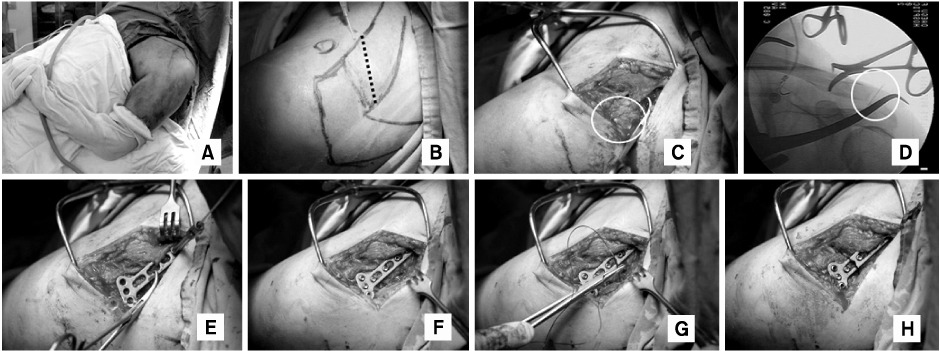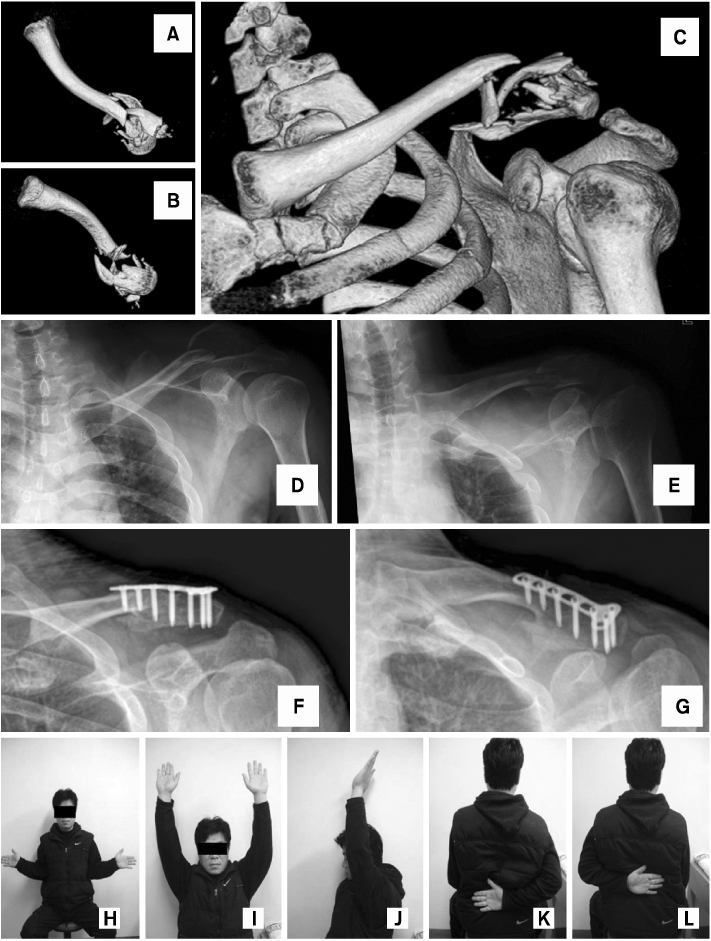J Korean Fract Soc.
2011 Jan;24(1):41-47. 10.12671/jkfs.2011.24.1.41.
The Surgical Outcomes of Clavicle Lateral End Fractures Fixed with the Oblique T Locking Compession Plate
- Affiliations
-
- 1Department of Orthopedic Surgery, Daegu Fatima Hospital, Daegu, Korea. fatimaos@unitel.co.kr
- KMID: 1449415
- DOI: http://doi.org/10.12671/jkfs.2011.24.1.41
Abstract
- PURPOSE
The purpose of this study is to evaluate the surgical outcomes of the clavicle lateral end fracture fixed with an oblique T locking compression plate (LCP).
MATERIALS AND METHODS
Fourteen clavicle lateral end fractures were fixed with the oblique T-LCP and followed up for at least 1 year after the surgery. Thirteen cases were unstable Neer type II fractures and one case was nonunion of the Neer type I fracture. The mean age was 46 years of age (range, 26~70). In ten cases, augmenting sutures with the absorbable suture material were placed in the coraco-clavicular ligament and around the plate and the clavicle to improve the stability of fracture fixation. Autogenous iliac bone graft was done in four cases. The clinical outcomes were evaluated by using UCLA scoring system and KSS (Korean Shoulder Score).
RESULTS
The mean UCLA score was 33.5 and the mean KSS was 94.9. Average time of bone union was 11.9 weeks (range, 6~28), including 1 case with a delayed union. There was no complication such as loss of fixation or nonunion.
CONCLUSION
Fixation with the oblique T-LCP is a good option providing reliable functional results in clavicle lateral end fractures.
Figure
Cited by 1 articles
-
Results of Hook Plate Fixation of Unstable Distal Clavicle Fractures
Hoon-Sang Sohn, Byung Chul Jo
J Korean Fract Soc. 2011;24(4):335-340. doi: 10.12671/jkfs.2011.24.4.335.
Reference
-
1. Ahn BW, Yoon JH, Kim CK, et al. Internal fixation of clavicle lateral and fracture with mini T-plate. J Korean Fract Soc. 2005. 18:410–414.
Article2. Allman FL Jr. Fractures and ligamentous injuries of the clavicle and its articulation. J Bone Joint Surg Am. 1967. 49:774–784.
Article3. Chun JM, Kim SY, Lee KW, Shin SJ, Kim EG. Modified tenson band fixation for unstable fracture of the distal clavicle. J Korean Orthop Assoc. 2002. 37:416–420.
Article4. Constant CR, Murley AH. A clinical method of functional assessment of the shoulder. Clin Orthop Relat Res. 1987. 214:160–164.
Article5. Craig EV. Rockwood CA, Green DP, Bucholz RW, Heckman JD, editors. Fracture of the clavicle. Fractures in adults. 1996. 4th ed. Philadelphia: Lippincott-Raven;1109–1161.6. Edwards DJ, Kavanagh TG, Flannery MC. Fractures of the distal clavicle: a case for fixation. Injury. 1992. 23:44–46.
Article7. Flinkkilä T, Ristiniemi J, Hyvönen P, Hämäläinen M. Surgical treatment of unstable fractures of the distal clavicle: a comparative study of Kirschner wire and clavicular hook plate fixation. Acta Orthop Scand. 2002. 73:50–53.
Article8. Goldberg JA, Bruce WJ, Sonnabend DH, Walsh WR. Type 2 fractures of the distal clavicle: a new surgical technique. J Shoulder Elbow Surg. 1997. 6:380–382.
Article9. Hessmann M, Kirchner R, Baumgaertel F, Gehling H, Gotzen L. Treatment of unstable distal clavicular fractures with and without lesions of the acromioclavicular joint. Injury. 1996. 27:47–52.
Article10. Kang HJ, Park KK, Yoon HK, Song HK, Hahn SB. T plate fixation for unstable fracture of distal clavicle. J Korean Fract Soc. 2006. 19:329–334.
Article11. Kao FC, Chao EK, Chen CH, Yu SW, Chen CY, Yen CY. Treatment of distal clavicle fracture using Kirschner wires and tension-band wires. J Trauma. 2001. 51:522–525.
Article12. Kona J, Bosse MJ, Staeheli JW, Rosseau RL. Type II distal clavicle fractures: a retrospective review of surgical treatment. J Orthop Trauma. 1990. 4:115–120.13. Lee KJ, Choi CH, Kim JM, et al. The Shoulder and elbow. 2007. 1st ed. Seoul, Korea: Young-Chang;290–291.14. Lee KJ, Choi CH, Kim JM, et al. The Shoulder and elbow. 2007. 1st ed. Seoul, Korea: Young-Chang;676–679.15. Neer CS 2nd. Fracture of the distal clavicle with detachment of the coracoclavicular ligaments in adults. J Trauma. 1963. 3:99–110.
Article16. Neviaser RJ, Neviaser JS, Neviaser TJ, Neviaser JS. A simple technique for internal fixation of the clavicle. A long term evaluation. Clin Orthop Relat Res. 1975. 109:103–107.17. Nordqvist A, Petersson C, Redlund-Johnell I. The natural course of lateral clavicle fracture. 15 (11-21) year follow-up of 110 cases. Acta Orthop Scand. 1993. 64:87–91.
Article18. Robinson CM, Cairns DA. Primary nonoperative treatment of displaced lateral fractures of the clavicle. J Bone Joint Surg Am. 2004. 86:778–782.
Article19. Shin SI, Song KW, Lee JY, et al. Treatment of type 2 distal clavicle fracture using wolter plate. J Korean Shoulder Elbow Soc. 2009. 12:14–20.
Article20. Sim E, Schwarz N, Höcker K, Berzlanovich A. Repair of complete acromioclavicular separations using the acromioclavicular-hook plate. Clin Orthop Relat Res. 1995. 314:134–142.
Article21. Yamaguchi H, Arakawa H, Kobayashi M. Results of the bosworth method for unstable fractures of the distal clavicle. Int Orthop. 1998. 22:366–368.
Article
- Full Text Links
- Actions
-
Cited
- CITED
-
- Close
- Share
- Similar articles
-
- Treatment of Clavicle Medial End Fracture Using Double-plate Fixation
- Clinical and Radiological Outcomes of Hook Plate Fixation in the Lateral End Fracture of the Clavicle and Acromioclavicular Dislocation
- The Surgical Outcome of Unstable Distal Clavicle Fractures Treated with 2.4 mm Volar Distal Radius Locking Plate
- The Radiologic Comparison of Operative Treatment Using a Hook Plate versus a Distal Clavicle Locking Plate of Distal Clavicle Fracture
- Comparative Analysis of the Results of Fixed-angle versus Variable-angle Volar Locking Plate for Distal Radius Fracture Fixation





